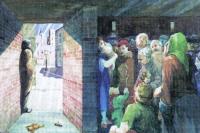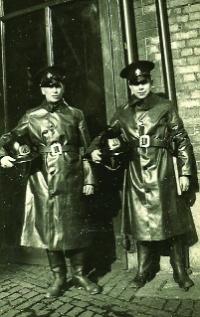When Dublin responded to blitzed Belfast’s may-day
Published in 20th-century / Contemporary History, Issue 3 (May/June 2011), News, The Emergency, Volume 19
The Shelter Warden, c. 1942, by Thomas A. Crawley. (Ulster Museum)
The response of the Dublin government to the urgent message from the war room at Stormont was remarkable, given the historically tense relations between the two jurisdictions. While hundreds of firemen from both Glasgow and Liverpool were dispatched, they could not reach Belfast until much later on the day of 16 April, following the previous day’s bombings. Dublin’s assistance was required urgently.
Immediately upon the Ministry of Public Security’s request for the assistance of the Dublin Fire Brigade, men from the south would make the journey to the blitzed city of Belfast. From Dublin alone, three regular and three auxiliary engines would be sent. In addition, Dún Laoghaire, Drogheda and Dundalk each contributed an engine to the cross-border effort.
Writing in 1960, Dublin Fire Brigade District Officer Michael Rodgers recalled that, while the war had been raging for two years, ‘it all seemed very remote to me. I looked on it as a deadly game being played in different fields and followed it with a fascinated curiosity.’ No doubt such an attitude to the conflict was common. The Irish Sea, he noted, was his protecting moat. With the bombing of Belfast, all changed dramatically. ‘Life had been lost and property damaged. My moat had been crossed.’ Tragedy, District Officer Rodgers noted, knows no border.
The Dublin Fire Brigade would make two trips, the first on 16 April and the second on 5 May. After the first one, the matter was debated at Dublin Corporation, with Jim Larkin asking ‘by whose authority had the fire brigade left the jurisdiction of Éire and proceeded to the Six-Counties’. Another councillor responded to Larkin by enquiring whether, ‘supposing Galway had been bombed, would any questions have arisen had the Fire Brigade gone down there?’ Larkin insisted that they would indeed have arisen, and noted that his enquiries were in relation to payment of the men, as well as in relation to where liability would rest had one of the men been injured or died in the course of the cross-border assistance.
Fire brigade historian Tom Geraghty noted in his study of the Dublin service that the response to the appeal within the job had been extremely positive. He noted that within half an hour of the message’s reception the chief officer of the Dublin brigade, Major Comerford, ‘was addressing the Dublin firemen gathered from all stations at a meeting in Tara Street’.
The first engine on the road to Belfast came from Dorset Street station, which was under Station Officer Edward Blake and Third Officer Richard Gorman. The Dublin Fire Brigade had first been contacted at 5.10am by the Ministry of Public Security, and by 7.30am three pumps with crews had already left the city. District Officer Rodgers noted that ‘Balbriggan, Drogheda and Dundalk slept peacefully as we sped northwards’, and the men were greeted by customs officers on the border who waved them onwards.
The men were warmly welcomed in Belfast, with the Irish Independent of 18 April noting that ‘the fire brigades which attended from Éire have been greatly praised for their work, and as they passed through the city’s streets homeward bound after their errand of mercy they were heartily cheered by a grateful people’. The first men from the Dublin Fire Brigade had arrived in the city just before 10am, and the first engines departed the city before nightfall. While in Belfast, they had been exposed to a situation alien to Dubliners. District Officer Rodgers recalled hearing an air raid siren during the course of the day, and recalled that ‘I will never forget that wailing sound. From the roof top where I was standing the city looked so scarred and vulnerable.’

Dan O’Dowd and Jack Conroy—two wartime Dublin firemen. (Las Fallon)
In the South, the Irish Times editorial of the following day noted that ‘Yesterday for once the people of Ireland were united under the shadow of a national blow. Has it taken bursting bombs to remind the people of this little country that they have a common tradition, a common genius and a common home?’ The Sunday Independent recorded on 20 April that Belfast was still burying her dead, and that praise for the southern fire brigades was unstinted in all corners of Belfast.
Firemen from the Irish capital would return to Belfast on 5 May, with even more making the journey across the border with six pumps and an ambulance. This assistance was not forgotten by the Belfast Fire Brigade; when bombs rained down on Dublin itself in late May, it was reported by the Irish Independent that Belfast Fire Brigade approached Dublin to offer assistance if required. The Dublin Fire Brigade responded and thanked the northern fire-fighters for their kind offer.
An exhibition on the blitz will run at Belfast’s Linen Hall until the end of June 2011, and will include rare photographs of the city following the bombings, air raid patrol reports and rare video footage of the city. In Dublin, the story of the men who travelled across the border is just one of those told at the Dublin Fire Brigade Museum at the O’Brien Institute in Marino. HI
Donal Fallon is the editor of ‘Come Here To Me’, a blog on Dublin life and culture, http://comeheretome.wordpress.com/.
















